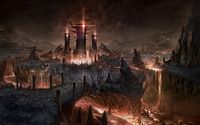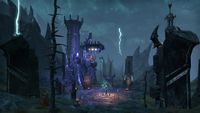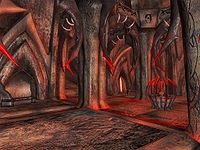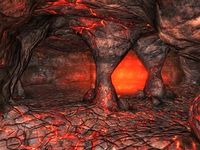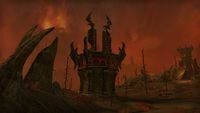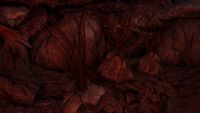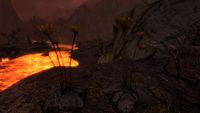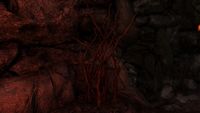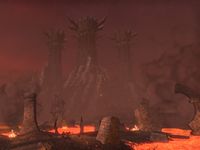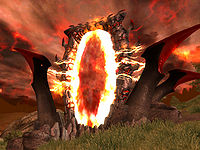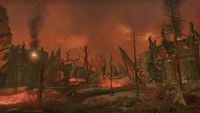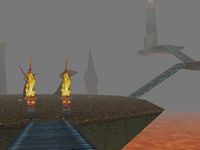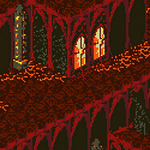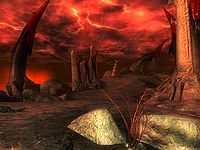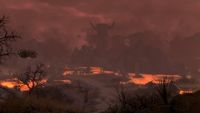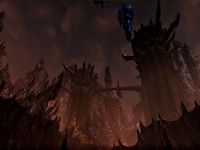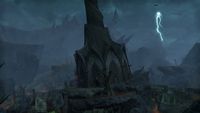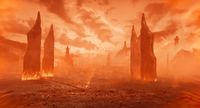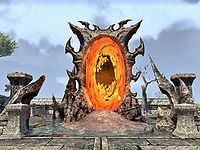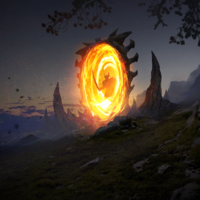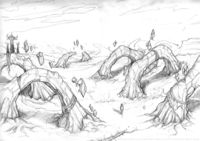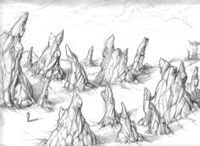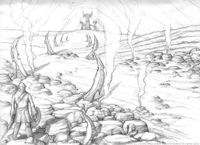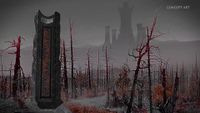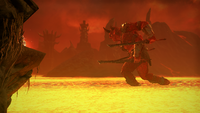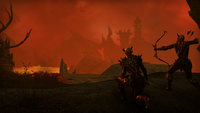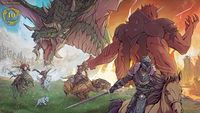Lore:Deadlands
| Deadlands | |
|---|---|
| Type | Plane |
| Realm | Oblivion |
| Appears in | Battlespire, Oblivion, Oblivion Mobile, ESO, Skyrim(CC) |
The Deadlands are a Daedric realm of Oblivion created and ruled over by the Daedric Prince of Destruction, Mehrunes Dagon. The embodiment of its creator's sphere, the dimension is fraught with natural disasters and destructive change. The area known as the Burn is covered by an ocean of lava, scattered with scorched volcanic islands and ruined structures. Many lesser Daedra roam the realm freely, but Dremora dominate the hierarchy.[1] The Sever is a region of the Deadlands with light soil covering jagged rock with sulfur pools throughout, fierce winds, and constant lightning storms. Destructive tornadoes and extremes in temperature characterize the region.[2][3] The capital of the Deadlands is known as Destruction's Solace.[4]
The force of Change, one of the Eleven Forces, flows strongly in the Deadlands, as all aspects of Dagon's sphere are rooted in Change. The currents flow so strongly that one who attempts to tap into change within the realm runs the risk of being swept away, and entering a synchroseiseiac state, becoming out of sync with reality and being scattered across time and space. Thus the realm is especially suited for those wishing to study that force. Some Daedra that reside in the Deadlands have thus learned how to read the flow of Change, granting them such clarity they're practically precognitive. [5][6]
—The Infernal City, pg. 239
Contents
Architecture[edit]
The Deadlands contain many monoliths, war gates, bridges, and towers, but many of these are defunct and ruined. The towers are built in a distinct Daedric style, with ornamental spikes, dim lighting, and rotting corpses strapped to the walls. Most towers have a hollow center, with several walkways leading up to the top floor and many twisting side passages. Smaller, peripheral towers are used to store prisoners and are navigated through the use of a "Corpse Masher", an elevator system used to execute captives. Many mechanisms are controlled through gear-based access systems, which can break easily. Large structures contain magical runes, teleport pads, Blood Wells, and Magicka Essence fountains (which are used for restorative purposes).[1]
Not all areas of the realm are as sophisticated, however. Wooden bridges and primitive torches are sometimes used in place of stone.[7] Lava tunnels run beneath the stormy surface, occasionally flooded with magma or toxic gases, but often incorporated into structures and used as a means to traverse the landscape. As such, these caves are inhabited with just as many Daedra as the surface, and Harrada roots often break through. Cruel traps are employed both inside the towers and around their exterior. Magical land mines and fire towers protect the keeps from outside invaders, while devious mechanized traps await those who find themselves within.[1]
Once, a network of dais portals crisscrossed the landscape. This network fell into disuse, but many of the daises still existed by the mid-Second Era.[8]
Flora[edit]
Despite the realm's inhospitable environment, life still manages to flourish in the most hostile regions of Deadlands. In certain areas, it appears that nothing but burnt grass and dead trees dot the landscape, but appearances can be deceiving.[7] While it may seem the fauna are the only living things, the Deadlands is actually quite lush with living flora. What appear to be charred and lifeless husks are still very much living plants that thrive in the Deadlands' destructive cycles. Several examples of tree are the Ember Oak which feeds on lightning strikes, the Deadlands Pine, and End Times Ash Tree, which must be burned to renew its lifecycle.[9] For underbrush there is Bloodgrass, aggressive Harrada Roots and poisonous Spiddal Plants that grow abundantly in the charred soil. Despite the barren and volcanic nature of the Burn, the region has a large array of wildlife.[10]
Fauna[edit]
All manner of lesser Daedra inhabit the realm, from the lowly stunted scamp to powerful Xivilai.[1] The realm is also home to many unique forms of Daedra,[11] such as the fiery Nightmare Courser, Nightmare Senche, and Nightmare Wolf. These flaming black beasts may resemble the creatures of Tamriel, but their true origins are obscure, and many see the hand of Mehrunes Dagon in their creation.[12][13][14] The Magma Scamp is another native of the Deadlands, recognizable by its molten black skin wreathed in flames.[15] The Mudcrab of Eternal Doom is a scuttling horror which superficially resembles the mudcrabs of Tamriel, but which seemingly thrives in the scorching heat and relentless desolation of the Deadlands.[16] Among the most powerful of Dagon's servants is the mighty Ash Titan, a fiery variant of the Daedric Titan first created by Molag Bal in imitation of the dragons.[17][18]
Hierarchy[edit]
Lord Dagon rules the realm, but his servants follow a warlike, patriarchal hierarchy. The Kyn act as the Prince's chief servants. Closest to Dagon is the Valkyn, his personal guard. The Valkynaz serve as commanders of operations of particular importance to Dagon, but usually stay by his side. Below the Valkyn is the Markyn, Mehrunes Dagon's Council of Lords. A Kynmarcher is the lord and high officer of a citadel, outpost, or gate; he controls both a clan fighting unit and a fief, a territory for which he is responsible. The lowest ranked Kynaz are Churls, who are undistinguished rabble ferociously cruel to mortals and other Daedra but obsequious to their superiors. The many lesser Daedra of the realm are thought of as unthinking animals.[19] Clan Dagon is the main clan of the realm, but other lesser clans and castes are also represented. Dremora Clan, Xivilai's Clan and Shardai Clan are three of the more prominent; all three are administrated from the Havoc Wellhead.[7]
Clan politics were upset during Dagon's invasion of the Battlespire, when Dagon allied with the clanless Mazken, and took a Dark Seducer as his bodyguard and lover. Balance was restored when Imago Storm of Dremora Clan allied with a mortal hero and temporarily took control of Clan Dagon after the hero banished Faydra Shardai, Xivilai Moath and Mehrunes Dagon to the Void.[7]
Interactions With Tamriel[edit]
During the time of the Planemeld, the liminal barriers between Tamriel and Oblivion faltered, and Dagon used this opportunity to launch several minor invasions from the Deadlands circa 2E 582, sacking the city of Firsthold[20] and burning the city of Whisper Grove to ash.[21]
In the events leading up to the Imperial Simulacrum, the traitorous Jagar Tharn struck a deal with Mehrunes Dagon: in return for his aid in Tharn's plan to take over the Third Empire, Dagon was promised the Battlespire, the magical academy of the Imperial Battlemages located in a Slipstream Realm.[22] Dagon successfully invaded the Battlespire during the simulacrum by traveling through multiple realms linked to the Battlespire. An apprentice survived the assault, and followed the retreating army through Oblivion. Another apprentice was sent to the Battlespire, but further reinforcements were blocked by a Daedric sigil placed on the Weir Gate. Following the trail left by the previous apprentice (who had been captured by the Daedra), the hero arrived at Dagon's Hunting Lodge. This section of the Deadlands was haunted by the ghosts of mortals who had sworn to serve Dagon for eternity. The lodge itself was the domain of Dagon, where the Prince was keeping the captured apprentice hostage. Using Dagon's protonymic and neonymic, the Armor of the Savior's Hide, and the Broadsword of the Moon Reiver, the hero banished the Daedra Lord to Oblivion and rescued their fellow apprentice. With its creator's banishment, the Lodge crumbled; the Battlespire was also destroyed, and its link with Oblivion severed.[7]
In 3E 433, Mehrunes Dagon launched an all-out invasion of Nirn. The Mythic Dawn assassinated Emperor Uriel Septim VII and all of his legitimate heirs. Without the Dragonfires to prevent permanent liminal bridges, the Mythic Dawn was able to create stable portals to the Deadlands, from which Daedra could invade. The Oblivion Crisis began with the sacking of Kvatch, when the Mythic Dawn opened a Great Gate to allow a Daedric Siege Engine to break through the city's defenses. The city was left to burn, with a single Oblivion Gate blocking its entrance. The Kvatch city guard, led by the Hero of Kvatch (and in some versions of the story, by Martin Septim),[23] stormed the Oblivion Gate, which linked to a region of the Deadlands called Ganonah. The force made their way to the Blood Feast, the Sigil Tower which housed the Sigil Stone that kept the Gate open. By removing the Stone from its place in the Sigillum Sanguis, the Tower and Gate were destroyed and the force was teleported back to Mundus.[24]
Armed with this information, many more Oblivion Gates were closed. The Imperial Legion were responsible for closing the Gates at Ione and Fort Sutch. The Knights of the Thorn attempted to close the Gate outside of Cheydinhal, which would have ended in disaster were it not for the intervention of the Hero of Kvatch. The Mythic Dawn's efforts to sack Bruma was discovered by the Blades; in response, the city guards were taught how to close the Gates, and the other Cyrodilic cities sent reinforcements once the threat of Daedric attack was neutralised. In a daring move, Martin Septim allowed the Mythic Dawn to open a Great Gate in order to retrieve its Great Sigil Stone. Leading an army against the Daedra, the Battle for Bruma was a victory.[24]
Although Cyrodiil was the center of the invasion, the other provinces fared much worse. The Old Holds of Skyrim and the town of Ald'ruhn on Vvardenfell were burnt to the ground. The Legion was stretched thin; despite the best efforts of the Telvanni mages, the Gates in Morrowind could not be suppressed. The Hist called many Argonians back to the Black Marsh, where they poured into the Deadlands in such numbers that the Daedra were forced to close the Gates. Vivec was rumored to have been taken by the Daedra, while Saint Jiub was killed. With each Gate that was opened, the liminal barrier was weakened, until eventually Mehrunes Dagon himself came through into Mundus for the first time since the First Era. The crisis ended when Martin shattered the Amulet of Kings and turned into the Avatar of Akatosh, defeating Dagon in a final battle in the Imperial City's Temple of the One. This sealed the liminal barriers permanently, preventing any future invasion.[24]
Circa 4E 201, the Mythic Dawn cultist Vonos devised a profane ritual which would shatter the liminal barrier and bypass Martin's sacrifice, allowing Dagon to once again invade Nirn and establish a foothold. Vonos managed to open a permanent Oblivion Gate in Skyrim by tricking the Last Dragonborn into killing him while holding a Great Welkynd Stone. The Dragonborn thereby inadvertently participated in the ritual, with Vonos' death serving as a mortal sacrifice. By destroying the Gate's Sigil Stone in advance, Vonos ensured that the portal could not be closed. Despite this, the planned Daedric invasion was foiled when the Dragonborn ventured into the Gate and slew Dagon's generals, Valkyn Methats and Valkyn Gatanas. The Vigil of Stendarr subsequently seized control of the Gate from the remaining cultists.[25]
Regions and Places[edit]
- Ashen Forest
- An isolated region with an abundance of dead trees. It is reportedly hidden from Mehrunes Dagon by unknown means.
- Atoll of Immolation
- A series of islands centered around a tower owned by the Havocrel Duke of Storms.
- The Burn
- A volcanic wasteland dominated by Dagon's legion and iron citadels.
- Ganonah
- A region in the Deadlands, whose native clan invaded Kvatch in the late Third Era.
- Isle of Joys
- An island region that was leased to the Longhouse Emperors and turned into one of their hunting retreats.
- Knives of Discord
- A region ruled by Valkyn Skoria from their tower, Red-Zeal Keep.
- The Sever
- A cold, and desolate desert wasteland constantly struck by lightning.
- Wretched Spire
- A settlement hidden in the southern hills of the Sever.
Gallery[edit]
See Also[edit]
- For game-specific information, see the Battlespire, Oblivion, Oblivion Mobile, Elder Scrolls Online
 , and SkyrimCC articles.
, and SkyrimCC articles.
References[edit]
- ^ a b c d Planes of Oblivion in Oblivion
- ^ Appearance of the Deadlands in ESO: The Deadlands
- ^ Flora and Fauna of the Sever — Anthropus Galia, Mages Guild Researcher
- ^ Lyranth's dialogue in ESO
- ^ Events of The Force of Change in ESO
- ^ Valsirenn's dialogue in ESO
- ^ a b c d e Level 7 in Battlespire
- ^ Madam Whim's dialogue in ESO
- ^ Flora and Fauna of the Sever — Anthropus Galia, Mages Guild Researcher
- ^ Flora and Fauna of the Burn — Anthropus Galia, Mages Guild Researcher
- ^ Lyranth the Foolkiller Answers Your Questions — Lyranth the Foolkiller
- ^ Packlord Nightmare Wolf description in ESO
- ^ Manelord Nightmare Senche description in ESO
- ^ Nightmare Courser description in ESO
- ^ Magma Scamp description in ESO
- ^ Mudcrab of Eternal Doom description in ESO
- ^ Ash Titan in ESO
- ^ Daedra Dossier: The Titans — Denogorath the Dread Archivist
- ^ Varieties of Daedra — Aranea Drethan
- ^ Firsthold objective in ESO
- ^ Razor's Edge and Return to Ash quests in ESO
- ^ ESO Loremaster's Archive — Lord Fa-Nuit-Hen and Tutor Riparius Answer Your Questions
- ^ The Illegitimate Son quest in Oblivion Mobile
- ^ a b c Main Quest in Oblivion
- ^ Events of The Consequences in Skyrim
